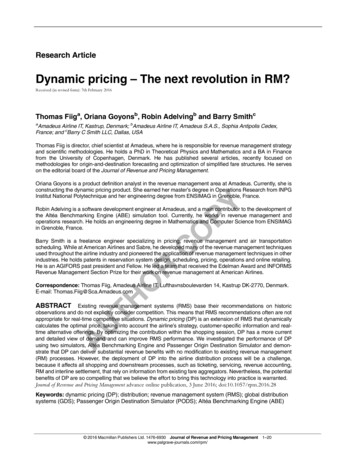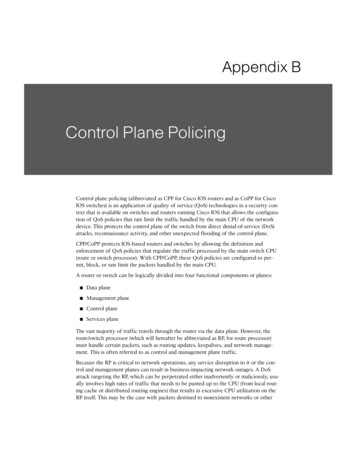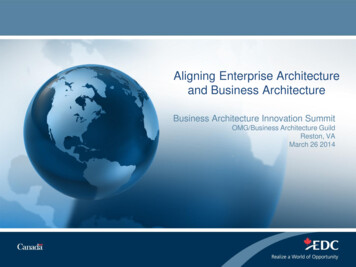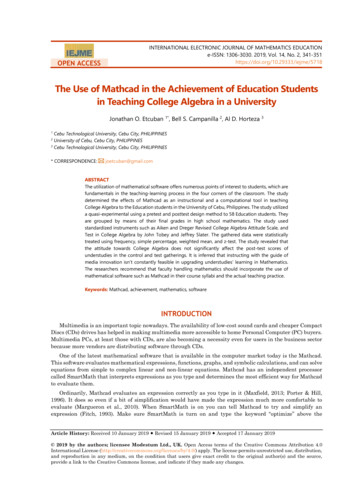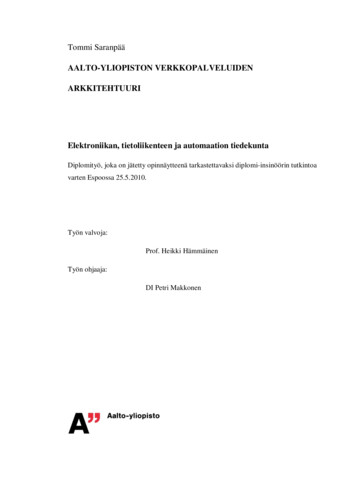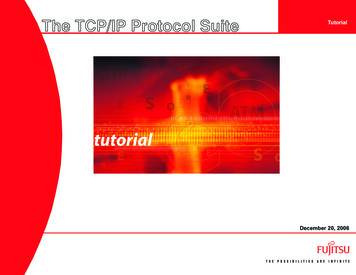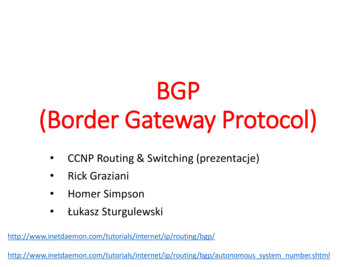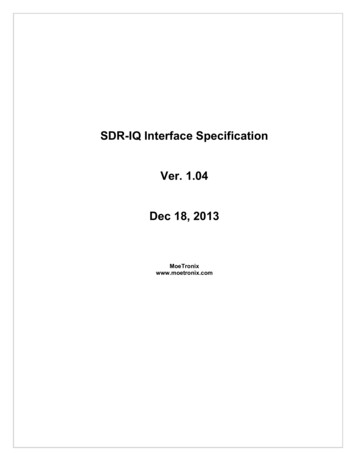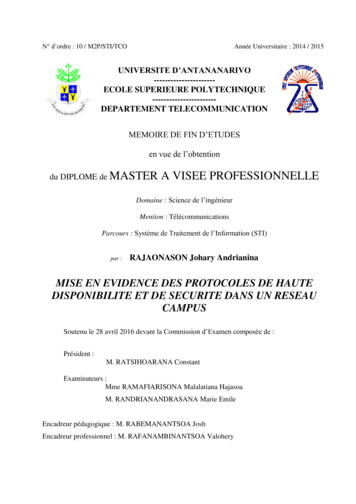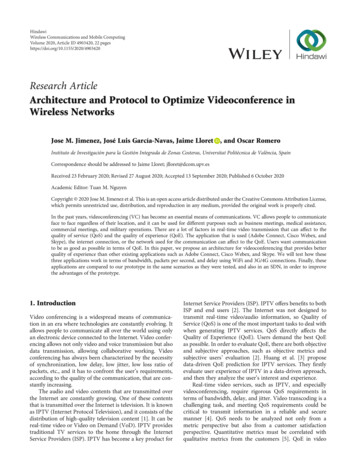
Transcription
HindawiWireless Communications and Mobile ComputingVolume 2020, Article ID 4903420, 22 pageshttps://doi.org/10.1155/2020/4903420Research ArticleArchitecture and Protocol to Optimize Videoconference inWireless NetworksJose M. Jimenez, José Luis García-Navas, Jaime Lloret , and Oscar RomeroInstituto de Investigación para la Gestión Integrada de Zonas Costeras, Universitat Politècnica de València, SpainCorrespondence should be addressed to Jaime Lloret; jlloret@dcom.upv.esReceived 23 February 2020; Revised 27 August 2020; Accepted 13 September 2020; Published 6 October 2020Academic Editor: Tuan M. NguyenCopyright 2020 Jose M. Jimenez et al. This is an open access article distributed under the Creative Commons Attribution License,which permits unrestricted use, distribution, and reproduction in any medium, provided the original work is properly cited.In the past years, videoconferencing (VC) has become an essential means of communications. VC allows people to communicateface to face regardless of their location, and it can be used for different purposes such as business meetings, medical assistance,commercial meetings, and military operations. There are a lot of factors in real-time video transmission that can affect to thequality of service (QoS) and the quality of experience (QoE). The application that is used (Adobe Connect, Cisco Webex, andSkype), the internet connection, or the network used for the communication can affect to the QoE. Users want communicationto be as good as possible in terms of QoE. In this paper, we propose an architecture for videoconferencing that provides betterquality of experience than other existing applications such as Adobe Connect, Cisco Webex, and Skype. We will test how thesethree applications work in terms of bandwidth, packets per second, and delay using WiFi and 3G/4G connections. Finally, theseapplications are compared to our prototype in the same scenarios as they were tested, and also in an SDN, in order to improvethe advantages of the prototype.1. IntroductionVideo conferencing is a widespread means of communication in an era where technologies are constantly evolving. Itallows people to communicate all over the world using onlyan electronic device connected to the Internet. Video conferencing allows not only video and voice transmission but alsodata transmission, allowing collaborative working. Videoconferencing has always been characterized by the necessityof synchronization, low delay, low jitter, low loss ratio ofpackets, etc., and it has to confront the user’s requirements,according to the quality of the communication, that are constantly increasing.The audio and video contents that are transmitted overthe Internet are constantly growing. One of these contentsthat is transmitted over the Internet is television. It is knownas IPTV (Internet Protocol Television), and it consists of thedistribution of high-quality television content [1]. It can bereal-time video or Video on Demand (VoD). IPTV providestraditional TV services to the home through the InternetService Providers (ISP). IPTV has become a key product forInternet Service Providers (ISP). IPTV offers benefits to bothISP and end users [2]. The Internet was not designed totransmit real-time video/audio information, so Quality ofService (QoS) is one of the most important tasks to deal withwhen generating IPTV services. QoS directly affects theQuality of Experience (QoE). Users demand the best QoEas possible. In order to evaluate QoE, there are both objectiveand subjective approaches, such as objective metrics andsubjective users’ evaluation [2]. Huang et al. [3] proposedata-driven QoE prediction for IPTV services. They firstlyevaluate user experience of IPTV in a data-driven approach,and then they analyze the user’s interest and experience.Real-time video services, such as IPTV, and especiallyvideoconferencing, require rigorous QoS requirements interms of bandwidth, delay, and jitter. Video transcoding is achallenging task, and meeting QoS requirements could becritical to transmit information in a reliable and securemanner [4]. QoS needs to be analyzed not only from ametric perspective but also from a customer satisfactionperspective. Quantitative metrics must be correlated withqualitative metrics from the customers [5]. QoE in video
2streaming is a task that can be improved in both wiredand wireless networks.QoE prediction consists of studying the relationshipbetween the user experience and features from the video.Some authors have investigated ways of improving QoE overwired networks by different ways. Mao et al. [6] propose anIPTV user QoE prediction algorithm based on the LongShort-Term Memory (LSTM) network. They select subjective and objective features and use the LSTM network toperform QoE modeling. Their proposal shows a higher performance in QoE prediction than other conventional neuralnetworks. Other authors such as Jiménez et al. [7] analyzeQoE from the point of view of the number of devicesconnected and the use of bandwidth. They study a basictopology on which a video is broadcasted and propose analgorithm to improve quality of experience when networkparameters can vary.Quality of experience can also be studied over wirelessnetworks. Su et al. [8] conducted a survey on existing literatures about video streaming QoE. They started from thepoint of view of the resource allocation problem and managed to bring together separated QoE metrics into seven categories. This allowed them to analyze their importance andcomplexity in video source coding and wireless networks.All these measurements can be used to carry out some otherinvestigations. QoE management systems can be developedto guarantee enough QoE in IPTV services [9]. Delay, jitter,bandwidth, and zapping time measurements are used tocalculate QoE over wireless networks, using a formula.Video streaming, including videoconferencing, consumes a substantial portion of network resources. Videotransmission requires high-bandwidth and strong latencyrequirements. Software-Defined Networking (SDN) givesthe possibility of changing the network dynamically. SDN,joined to other techniques oriented to improve videostreaming, can optimize video transmission through flexiblecontrols [10]. Jimenez et al. [11] carried out a performancecomparison between Mininet and a real network whenmultimedia streams were being delivered. Bandwidth, delay,and jitter were studied.Taking into account these issues, this paper proposes anarchitecture for videoconferencing to provide better qualityof experience than other existing solutions. First of all, thesystem used in our prototype is defined. This system consistsof an E2E QoE management scheme for real-time video communication structured in different layers. The system willhave three basic processes, which correspond to the basicactions to establish a videoconference: register, connection,and transmission process. Later, a finite-state machine is proposed, and also the different states are presented and defined.In addition, three different existing VC applications (AdobeConnect, Cisco Webex, and Skype) are tested in terms ofbandwidth, packets per second, and delay, using WiFi and3G/4G connections. Finally, these applications are comparedto our prototype in the same scenarios as they were testedand in another scenario where SDN is applied in order toimprove the advantages of the prototype.The remainder of this paper is organized as follows.Section 2 presents some related work. The architecture pro-Wireless Communications and Mobile Computingposal for videoconferencing is explained in Section 3. Section4 describes the proposal of the protocol of communication.The performance test in videoconference applications is carried out in Section 5. Section 6 presents the performance testof the developed application. And finally, Section 7 draws themain conclusions and future works.2. Related WorksThis section presents some works where video streaming, inparticular videoconferencing, is studied from different pointsof view.Chakraborti et al. [12] propose an audio/videoconferencing architecture based on the Virtualized Service EdgeRouter (VSER) platform. Their solution uses the VSERplatform for notifications and the ICN framework for dataexchange. This design provides good scalability and reliability,and it also allows discovering of new participants, dynamicsynchronization, and multicasting for data exchange.In [13], Hajiesmaili et al. discuss about the multipartycloud videoconferencing architecture. They study theadvantages of using cloud resources to effectively improvevideoconferencing performance. The proposed architectureconsists of using multiple agents that perform transcodingtasks. Each user is assigned to the best agent in terms ofbandwidth and processing availabilities for each one. Theirsolution decreases the operational cost and reduces conferencing delays.There are many papers that present improvements andsolutions for videoconferencing using WebRTC for differentpurposes. Jang-Jaccard et al. [14] propose a design andimplementation of a practical videoconferencing system fortelehealth using WebRTC technology. Their goal is to evaluate the possibility of improving healthcare outcomes by highbandwidth-enabled telehealth services. Their solution seeksto be standard-based, interoperable, simple, and inexpensive.They show the limitations of using WebRTC, describe various insights into the prototype implementation, and providecode snippets.Bestak and Hlavacek [15] discuss a videoconferencingplatform based on WebRTC technology. They test the impacton the multiplexing server’s CPU load and RAM requirements for different numbers of users, using different hardware and software configurations at end-point devices. Theresults show a strong relation between the video resolutionand bit rate, and the importance of dimensioning the serveraccording to the number of users.Pasha et al. [16] show the shortcomings and challengesfaced by videoconferencing through WebRTC and proposea Multipoint Control Unit (MCU) as a solution. They propose the best centralized architecture to support WebRTCby using MCU. Their aim is to expose how WebRTC worksand how it can be improved.Many other authors propose other different solutions forcarrying out videoconferencing. Gusev and Burke [17]present a discussion about the design and implementationin C of Real-Time Videoconferencing over Named DataNetworking (NDN-RTC) on an NDN testbed. They buildthe solution in C using the WebRTC library due to the
Wireless Communications and Mobile Computingnecessity of reasonable CPU and bandwidth efficiency. Theygenerate a functional low latency streaming tool that can beused as a platform for studying design challenges in realtime media over NDN.Sambath et al. [18] face the task of improving the QoSscheme in an IP multimedia subsystem (IMS) for videoconferencing. They implement IntServ and DiffServ with MPLSand study parameters such as end-to-end delay, packet loss,and jitter. Their investigation shows that proper adaptationof QoS and appropriate resource allocation provide qualitative transmission of videoconferencing in a wireline.Hossain and Khan [19] investigate a novel MultipointVideoconferencing (MVC) architecture potentially suitablefor a Peer-to-Peer (P2P) platform, such as Gnutella. Theirproposal is based on the idea that autonomous peer nodescan dynamically assume the role of the MCU. This ideaimproves the architecture by minimizing total traffic, individual node hotness, and video composition delay.Video conferencing is widely used for medical purposes,and many papers are focused on how technologies canimprove videoconferencing for health. Khalifeh et al. [20]describe an e-health videoconferencing platform to facilitatepatients’ follow-up and communication with their healthcareprofessionals from a distance and at low cost. This system isdeveloped for its potential usage in the Jordanian healthcaresystem and, in particular, medical centers and hospitalslocated in the rural areas. The main challenge is its high cost,so the proposed platform seeks to provide similar service at alower cost.In [21], Taylor et al. study which technical factors influence the quality of videoconferencing in the home settingand evaluate the impact of these factors on the clinical perceptions and acceptance of videoconferencing for health care.They conclude that the quality of videoconferencing whenusing 3G instead of broadband fiber-based services was lessdue to failed calls, jitter, and video pixilation.Mat Kiah et al. [22] propose a secure framework forhealth videoconferencing systems and a complete management solution for secure videoconferencing groups. Theyuse Real-Time Transport Protocol over UDP to transmitinformation, and they also use RSA and AES algorithms toprovide security services. Their study shows that an encryption algorithm insignificantly increases the videoconferencing computation time.Furthermore, the correct operation of videoconferencingdepends on secure and reliable communication such as goodQoS and QoE. Many papers are focused on these aspects.Mishra et al. [23] study how cryptographic techniques areused to achieve security protection to videoconferencing.The authors propose a novel, computationally efficient andsecure video encryption algorithm. Security and performanceanalysis are carried out over their algorithm and show that itis well secured, computation efficient, and applicable for reallife operations.Pattaranantakul et al. [24] present an achievable securevideoconferencing system based on quantum key encryption.They propose a secure key management methodology toensure a trusted quantum network and a secure videoconferencing system. Their proposal includes secure communica-3tion channels to exchange secret keys and management.The authors point out that encryption can produce someinitial delay.Zhao et al. [25] present an overview of selected issuesabout QoE and its application in video transmission. Theauthors study QoE modeling, assessment, and managementof video transmission over different types of networks.Gunkel et al. [26] study different video stream configurations and layouts for multiparty conferencing in respect toindividual network limitations. This study explores the relationship between QoE and three different factors: layout, videoquality (resolution), and network limitations (packet loss).In [27], García et al. show the procedure to set up a serverto support the MPEG DASH protocol in the Polimediae-learning System. They use this server to present asubjective QoE study to evaluate the performance of MPEGDASH. The authors determine the aspects that are mostannoying to users of Polimedia. They carry out this studyin order to improve the QoE of the user. They conclude thatan 8-second video is the most stable segment size for videosof Polimedia.Finally, all the solutions, ideas, and improvements presented before can be improved by using SDN, due to thepossibility of changing the network dynamically and adapting it to the necessities. Henni et al. [28] focus on animprovement of the traditional OpenFlow Controllers. Theypropose a dynamical QoS routing implemented by a newcontroller. This new way of routing supports video conferencing flow delivery over OpenFlow networks. Dynamicalrouting focuses on protecting such traffic over nonconstrained flows. Their proposal simulated under Mininetshows the effectiveness of the proposed approach.Yang et al. [29] propose a videoconferencing architecturebased on SDN-enabled Scalable Video Coding (SVC) multicasting. The architecture discards the traditional InternetGroup Management Protocol (IGMP) and MCU to obtaina better performance. Their results show that their systemcan provide flexible and controllable video delivery, canreduce the network bandwidth usage, and can guaranteethe quality of a videoconference.Al Hasrouty et al. [30] investigate the impact of usingSVC and SDN techniques on videoconferencing. Their aimis to reduce the bandwidth consumed by videoconferencing(using SDN) and take advantage of SVC by sacrificing videoquality for usability purposes. Their algorithm defines whereand how many video layers should be dropped in order toadapt the streams to the bandwidth capacities of the network.Our proposal improves the methods previously described.We ensure better End-to-End (E2E) QoE in videoconferencingby using the Network-adaptive Control Protocol, adjusting thetransmission to the optimal values based on the characteristicsof the devices and network. In addition, our proposal includesthe use of SDN to get an optimal network transmission.3. Architecture Proposal for Video Conference3.1. System Definition. We must define an E2E QoE management scheme for real-time video communication systems,including those operating in resource varying environments.
4Wireless Communications and Mobile ComputingQoEApplicationPresentationE2E GUMTS/3GHSDPA/3.5GData linkLTE Advanced/4G5GWiFiWiMAXWiBROPhysicalFigure 1: Proposed layer architecture, according to the type of QoS and QoE parameters.In our proposal, we define a human visual perceptionbased E2E QoE metric and the methodology for correlatingthis metric to real-time video data, application/network-levelQoS measurements, the capabilities of user devices, and subjective user factors.Initially, to use it in our work, different groups of usersobserved the transmission of multiple videoconferences.The subjective quality of each videoconference was definedby the user’s perception. This is measured in mean opinionscore (MOS), from 1 to 5, where 1 is perceived as very badquality, and 5 is considered very good quality. In this way,we obtained a subjective QoE classification to apply to thedifferent transmissions. In addition, we vary the networkparameters and the characteristics of the streams used inthe communication equipment in each one of them, so thatin the proposal of our system, what we do is adjust the maximum QoE selected by our users, based on to the parametersthat are obtained from the computers that are communicating and the network.We also define network-adaptive video-encoding anddecoding algorithms utilizing device-based E2E QoE-drivenfeedback and, where available, network-based E2E QoEdriven feedback to achieve real-time adaptation accordingto the available device and/or network resources.Besides, we define real-time device-based and networkbased feedback control mechanisms that can be used to regulate E2E QoE by one or more of the following methods:application-level objective measurement and reporting ofthe actual received real-time video signal quality; networklevel objective measurement and reporting of the in-transitreal-time video signal quality; application-level measurement and reporting of device and/or network resourcesand QoS performance; and network-level measurementand reporting of device and/or network resources and QoSperformance.To carry out these objectives, we will consider whichparameters affect the QoE, which algorithm is the mostappropriate for the network, which algorithms are the mostappropriate to provide the best QoE for end-user devices,how to make the network “adaptive” for this case, and whatis the best system decision procedure to provide an“adaptive” network.The proposed layer architecture, according to the type ofQoS and QoE parameters that are considered, is shown inFigure 1.An architecture that includes all the previously established objectives is shown in Figure 2.As can be seen in Figure 2, our architecture is based on aNetwork-adaptive Control Protocol. Through this protocol,we manage to adapt the transmission between the end usersto the maximum possible QoE. To achieve the goal, we musttake into account how to handle a large amount of information, at least during the initial process of the connection.Information can be classified depending on where theinformation is obtained from: obtained from the sourcedevices, obtained from the network between end users, orobtained from the destination device. The informationobtained from the source devices can be about available features of the devices (type of camera, CPU, RAM, and iOS),characteristics of device-based network analysis (bandwidth,delay, jitter, and packet loss), characteristics relative to videocompression that can be achieved (codecs supported by software), and data calculated from monitoring video-encodedtargets (bits/frame, frames/sec, and achievable QoE). Information that can be obtained from the network between endusers includes available features of the devices in all the networks where the communication between end users passthrough (bandwidth, delay, jitter, packet loss, and achievableQoE). Information that can be obtained from the destinationdevice includes available features of the devices (type of
Wireless Communications and Mobile Computing5CameraNetwork-adaptive control protocol:sending device elementsNetwork-adaptive control protocol:receiving device elementsDisplayNetworkDevice API: analyze availableresources(i) Camera module(ii) Device processingDevice API: analyze availableresources(i) Camera module(ii) Device processingDevice-based network analysis:(i) Available bandwidth(ii) Delay/jitter(iii) PacketlossNetwork APIs (if available)(i) Available bandwidth(ii) Delay/jitter(iii) Packet loss(iv) QoS policiesDevice-based network analysis:(i) Available bandwidth(ii) Delay/jitter(iii) Packet lossAnalyze temporal and spatialcompressibility of video framesCalculate and / or monitor videoQoE at receiving deviceCalculate and monitor video-encodedtargets:(i) Bits/frame(ii) Frames/sec(iii) Achievable QoEDeliver decoded video frames todisplay driverFeedbackCapture video frames fromcamera moduleReceiveSendNetwork-adaptive video encodingto maximize E2E QoE atreceiving device(i) Postprocessing(ii) Packetize frames(iii) Transmit buffer(i) Receive buffer(ii) Depacketize frames(iii) PreprocessingDecode video frames to maximize E2EQoE at the receiving deviceHuman visual perception-basedmetrics for E2E user QoEFigure 2: Architecture that includes all the established objectives.camera, CPU, RAM, and iOS), characteristics of device-basednetwork analysis (bandwidth, delay, jitter, and packet loss),and data calculated from monitoring video-encoded targets(bits/frame, frames/sec, and achievable QoE).Figure 3 shows a generic communication protocolbetween two users connected to two different service providers, for the establishment of the call. Later, in Section 4,we will detail the proposed protocol for our architecture.3.2. System Process. In order to design the architecture, we propose three basic processes. They correspond to the basic actionsto establish a video communication. Each process is associatedto a set of states and transitions that will be detailed later whenthe system state machine is explained. Figure 4 shows the relationship between the processes of the system. The register process is the start and end process of the system. It is the onlyprocess that requires the user’s intervention for executing it.System processes, with the states of each process, are nextdescribed in detail.3.2.1. Register Process. This process includes three states: Idlestate, Registered state, and Failed state. The user, when start-ing or ending the videoconference, is in the Idle state. Fromthe Idle state, the user enters the Registered state where thefinal user with whom it will establish the communication willbe identified and selected. The Failed status will be reachedwhenever video communication is interrupted for any reason. From the Failed state, the user passes to the Idle statewhere they can try again to start a new videoconference.3.2.2. Connection Process. This process includes two states: theActive state and the Established state. The Active state isaccessed after the registration phase, that is, when the connection is requested through the application used to connect to theend user. In this state, the initial information exchange of theadjustment parameters occurs, which are used by the connected users. The Active state is also reached, from theForwarding state, in the case of a small failure during the transmission, trying to recover the transmission again before reaching the Failed state. From the Active state, users can arrive tothe Failed state when it is impossible establish the connectionwith the final user. The Established state is accessed only fromthe Active state. In this state, videoconference begins. From theEstablished state, only the Forwarding state can be reached.
6Wireless Communications and Mobile ComputingServiceprovider 1InternetServiceprovider 2E2E QoESource clientService provider 2Service provider 1Connection phaseConnection request tothe destination clientConnection request to thedestination clientAck authentication provider profileDestination clientConnection request to thedestination clientAck connectionAck connectionAck connectionNegotiation phaseDevice sourcefeaturesDevice sourcefeaturesDevice destinationfeaturesDevice destinationfeaturesVideo Device sourcefeaturesDevice onferenceFigure 3: Communication protocol between two users connected to two different service providers.establish communication with the end user, it is passedto the Failed state.ConnectionRegisterTransmissionFigure 4: System processes of videoconference architecture.3.2.3. Transmission Process. This process includes only onestate: Transmission state. Users arrive at the Forwarding statefrom the Established state, when users have already begunthe video communication. In this state, the instantaneousparameters of the devices and the network are controlledperiodically. In case of need, the characteristics of the videocommunication are varied. In the event of a small communication failure, we can try to reenter at the Active state, andif the transmission is terminated or it is impossible to3.3. Finite-State Machine. Figure 5 shows the System FiniteState machine. We can see its different states and the transitions between states. In this section, we describe each state ofthe system and the conditions and events that will make thenode change from one state to another inside a process.The processes included in Figure 5 are as follows.3.3.1. Idle State. At first, this is the state where the user is,before initiating access to the application to establish thevideoconference, or once the videoconference is finished.Then, after the application is selected to make a videoconference, the user will go from this state to the Registered state.3.3.2. Registered States. This state is accessed only from theIdle state. The user initiating the videoconference, dependingon the employed software, must initiate the authenticationprocess in the server. Once authenticated, it will search forthe remote user that it wants to connect to, in its own databaseor in the server database. Once the end user is found, it willdemand the connection with the selected end user to theserver. The server tries to make contact between the users to
Wireless Communications and Mobile Figure 5: Finite-State machine.User originRegistrar serverConnectioEnd usern requestquestentials retion credAck connecSend credentialsentialsAck send credService access requestService accept(code)Access infoAck servicfoAck access ine acceptService requestAccess coderequestSend codeAck send codeFigure 6: Protocol proposed for the Idle and Registered states.establish an initial connection, and they will go to the Activestate. In case the user that is initiating the call does not wantto connect with any of the available users or cannot establisha connection with the end user, it will go to the Failed state.3.3.3. Active State. This state can be reached from the Registered or Forwarding states. From the Active state, we canmove to the Established or Failed states. Once the initial contact between the users participating in the videoconference
8Wireless Communications and Mobile ComputingUser originEnd userRequestparameters adjusters adjustAck parametRequest start video coAck requestnferencenferencestart video coFigure 7: Protocol proposed for the Active state.User originEnd userForwardingaudio andvideoFigure 8: Protocol proposed for the Established state.User originEnd userForwardingaudio andvideoadjustparametersvideo ackTime outandAck audioSend parameters adjustd video ck audio aners adjustack parametATime outSend parameters adjustjust Ack videoeters adAck paramFigure 9: Protocol proposed for the Forwarding state when the videoconference is running correctly.has been established, in the Active state, an exchange ofparameters between the end devices of the users will be initiated, at the same time that the information of the networkparameters is obtained. Using the information obtained, analgorithm to get an agreement to reach the maximum E2EQoE among the users at that moment will be applied. Fromthis moment on, it will go to Established status. In case thatone of the two users rejects or terminates the connection,or a connection agreement cannot be reached due to theparameters of any of the user devices or of the network, it willgo to the Failed state.3.3.4. Established State. Established status can only bereached from the Active state. From the Establishedstate, you can only move to the Forwarding state. Oncethe Established state is reached, the video starts from thedevices of the connected users, moving to the Forwarding state.
Wireless Communications and Mobile Computing9User originEnd userForwardingaudio andvideoTime outio andudAck aOut of timevideoFail forwarding videoFigure 10: Protocol proposed for the Forwarding state when there is a problem.User originEnd userRequest parameters adjustFailed connectionRequest parameters adjustFailed connectio
commercial meetings, and military operations. There are a lot of factors in real-time video transmission that can affect to the quality of service (QoS) and the quality of experience (QoE). The application that is used (Adobe Connect, Cisco Webex, and Skype), the internet connection, or the network used for the communication can affect to the .
